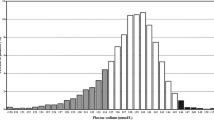Abstract
Purpose
Hyponatremia in hospitalized patients has been reported to be associated with in-hospital mortality. We studied patients treated at our hospital for hip fracture regarding the factors related to hyponatremia at admission.
Methods
Among 580 patients aged 60 years or above who were admitted to our hospital since January 1997 for treatment of hip fracture, 512 patients (110 males, 402 females) from whom serum sodium level at admission was available were studied. In 512 patients, the age at injury ranged from 60 to 103 (mean 82.6) years. Fracture types were femoral neck fracture in 191 patients, and trochanteric fracture in 321. These patients were divided into two groups by the blood sodium level at admission: a hyponatremia group with sodium levels lower than 135 mEq/L, and a normonatremia group with sodium levels within normal range. The age, gender, fracture type, residence before injury, pre-injury walking capability, anemia at admission, liver function, kidney function, inflammatory status, urinary glucose status, lung disease, ECG abnormality, systemic chronic disease, status of dementia, treatment modality, hospital stay (days), and in-hospital death were investigated. First a univariate study was conducted to identify the factors that differ significantly between the two groups. Then multivariate analysis was conducted using the parameters with significant difference as independent variables
Results
Hyponatremia was found in 49 of 512 (9.6 %) patients. In univariate analyses, six factors (age; residence before injury; anemia; dementia; treatment modality; in-hospital death) were significantly different between the hyponatremia group and normonatremia group. Multivariate analysis identified in-hospital death [odds ratio (OR) = 3.64, p = 0.035] and age (OR = 1.05, p = 0.029) as independently associated with hypernatremia.
Conclusion
Hyponatremia at admission is prevalent in old aged patients with fracture, and is related to in-hospital death.
Similar content being viewed by others
References
Antonelli Incalzi R, Gemma A, Capparella O, Terranova L, Sanguinetti C, Carbonin PU (1993) Post-operative electrolyte imbalance: its incidence and prognostic implications for elderly orthopaedic patients. Age Ageing 22(5):325–331
Asadollahi K, Beeching N, Gill G (2006) Hyponatraemia as a risk factor for hospital mortality. QJM : Mon Assoc Physicians 99(12):877–880
Beloosesky Y, Hershkovitz A, Solovey B, Salai M, Weiss A (2011) Hip fracture post-operation dysnatremia and Na+-courses in different cognitive and functional patient groups. Arch Gerontol Geriatr 53(2):179–182
Bentler SE, Liu L, Obrizan M et al (2009) The aftermath of hip fracture: discharge placement, functional status change, and mortality. Am J Epidemiol 170(10):1290–1299
Chawla A, Sterns RH, Nigwekar SU, Cappuccio JD (2011) Mortality and serum sodium: do patients die from or with hyponatremia? Clin J Am Soc Nephrolo :CJASN 6(5):960–965
Chin TL, Liu G, Shen L, Hee KW (2010) A decade of in-hospital fracture mortality review: an analysis of 8700 patients. J Bone Jt Surg 92(1):496–497
Flear CT, Singh CM (1973) Hyponatraemia and sick cells. Br J Anaesth 45(9):976–994
Frenkel WN, van den Born BJ, van Munster BC, Korevaar JC, Levi M, de Rooij SE (2010) The association between serum sodium levels at time of admission and mortality and morbidity in acutely admitted elderly patients: a prospective cohort study. J Am Geriatr Soc 58(11):2227–2228
Frost SA, Nguyen ND, Black DA, Eisman JA, Nguyen TV (2011) Risk factors for in-hospital post-hip fracture mortality. Bone 49(3):553–558
Funk G-C, Lindner G, Druml W et al (2010) Incidence and prognosis of dysnatremias present on ICU admission. Intensive Care Med 36(2):304–311
Gill G, Huda B, Boyd A et al (2006) Characteristics and mortality of severe hyponatraemia—a hospital-based study. Clin Endocrinol 65(2):246–249
Gill G, Leese G (1998) Hyponatraemia: biochemical and clinical perspectives. Postgrad Med J 74(875):516–523
Hagino T, Ochiai S, Wako M, Sato E, Maekawa S, Hamada Y (2008) Twin hook fixation for proximal femoral fractures. J Orthop Surg (Hong Kong) 16(2):162–164
Hagino T, Sato E, Tonotsuka H, Ochiai S, Tokai M, Hamada Y (2006) Prediction of ambulation prognosis in the elderly after hip fracture. Int Orthop 30(5):315–319
Hoorn EJ, Liamis G, Zietse R, Zillikens MC (2012) Hyponatremia and bone: an emerging relationship. Nat Rev Endocrinol 8(1):33–39
Jiang HX, Majumdar SR, Dick DA et al (2005) Development and initial validation of a risk score for predicting in-hospital and 1-year mortality in patients with hip fractures. J Bone Mineral Res 20(3):494–500
Leibson CL, Tosteson AN, Gabriel SE, Ransom JE, Melton LJ (2002) Mortality, disability, and nursing home use for persons with and without hip fracture: a population-based study. J Am Geriatr Soc 50(10):1644–1650
Lewis JR, Hassan SKZ, Wenn RT, Moran CG (2006) Mortality and serum urea and electrolytes on admission for hip fracture patients. Injury 37(8):698–704
Magaziner J, Simonsick EM, Kashner TM, Hebel JR, Kenzora JE (1989) Survival experience of aged hip fracture patients. Am J Public Health 79(3):274–278
McPherson E, Dunsmuir RA (2002) Hyponatraemia in hip fracture patients. Scott Med J 47(5):115–116
Pimlott BJ, Jones CA, Beaupre LA, Johnston DW, Majumdar SR (2011) Prognostic impact of pre-operative albumin on short-term mortality and complications in patients with hip fracture. Arch Gerontol Geriatr 53(1):90–94
Waikar SS, Mount DB, Curhan GC (2009) Mortality after Hospitalization with Mild, Moderate, and Severe Hyponatremia. Am J Med 122(9):857–865
Wald R, Jaber BL, Price LL, Upadhyay A, Madias NE (2010) Impact of hospital-associated hyponatremia on selected outcomes. Arch Intern Med 170(3):294–302
Whelan B, Bennett K, O’Riordan D, Silke B (2009) Serum sodium as a risk factor for in-hospital mortality in acute unselected general medical patients. QJM : Mon J Assoc Phys 102(3):175–182
Conflict of interest
None.
Author information
Authors and Affiliations
Corresponding author
Rights and permissions
About this article
Cite this article
Hagino, T., Ochiai, S., Watanabe, Y. et al. Hyponatremia at admission is associated with in-hospital death in patients with hip fracture. Arch Orthop Trauma Surg 133, 507–511 (2013). https://doi.org/10.1007/s00402-013-1693-x
Received:
Published:
Issue Date:
DOI: https://doi.org/10.1007/s00402-013-1693-x




